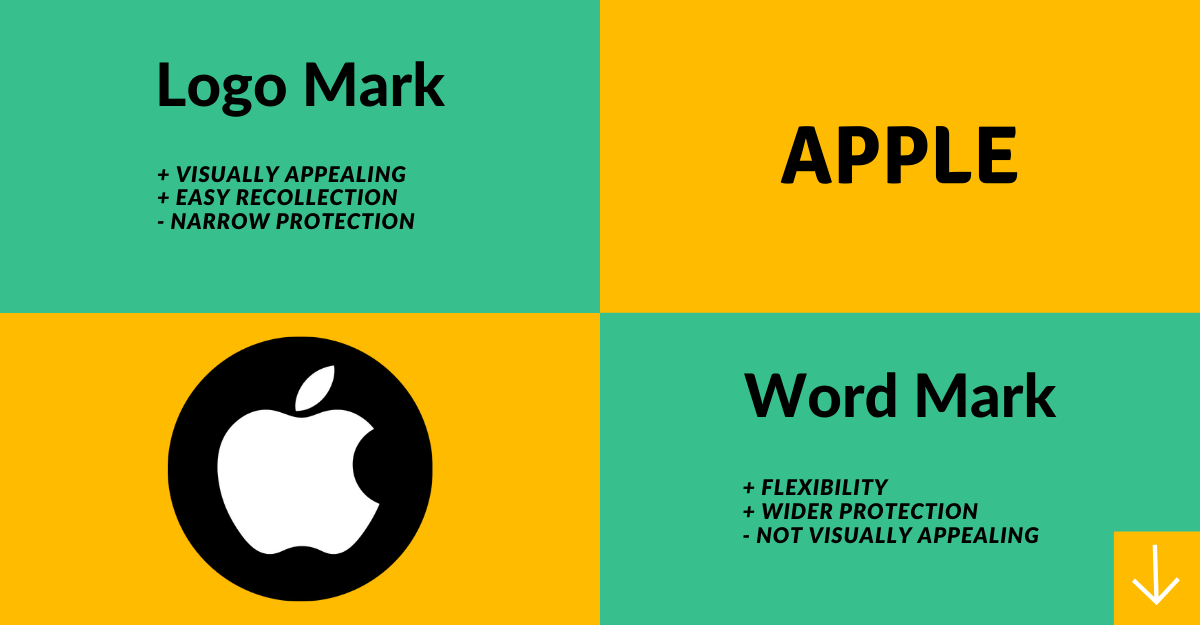Difference between wordmark and logo mark
A trademark is a vital tool in protecting the identity of a business. It helps people recognize the source of the products or services they use. As such, it helps in building the goodwill of a business. Given the importance of a trademark in any business, you must be very careful when choosing your trademark. There are two common kinds of trademarks: wordmarks and logo marks (device marks). When filing a trademark application, the most common dilemma is choosing a word mark or a logo trademark.
What is a word mark?
A word mark is where you only seek to register the words or letters. This means that only the combination of words or letters is registered. No attention is paid to the style in which the letters or words are represented, design, font size, or any other graphic feature of the words or letters. The words or letters are registered irrespective of their manner of representation. You seek protection for the words or letters.
Let’s take an example to understand this well. Let’s say I want to register the words FEATHER WIN. If I choose to register it as a word mark, then only the words FEATHER WIN will be registered. Nothing matters, be it the font size, the style, all caps, or not. As long as the spelling remains the same, once registered, I can choose to represent the word mark however I want.
What is a logo mark?
A logo mark (device mark) is a graphic design or image which may or may not have wordings. It is a stylized logo. You can choose to represent the design with color or in black and white. If you represent the Logo in color, then you will have to use the same colors throughout. You cannot choose different colors from what you registered as a trademark.
If FEATHER WIN was represented like this:

It would be a logo mark. If this Logo is registered, you must use the same Logo with the same violet and red color combinations whenever you are depicting the Logo. Here, it is also essential to understand that the Logo is the design that is described above, and the brand name is FEATHER WIN. So, while registering a design mark, you can choose whether you want to incorporate the brand name in the Logo or not. If you’re going to register just the Logo without the brand name, you can do that if you want to register FEATHER WIN as a logo mark without the brand name on it.
Pros of registering a mark as a word mark:
Flexibility is the most important advantage of registering a mark as a word mark. As already stated above, a word mark protects only the words or letters. This means that a word mark can be represented in any manner. A word mark, therefore, ensures broader protection as the words are protected irrespective of style. You can vary the design aspects of the word without worrying about losing trademark protection. You only have to ensure that the spelling of the word or words remains the same.
Moreover, if you want to register the Logo, as well as the word, as trademarks, it could turn out to be an expensive affair. Instead, you can register the mark as a word mark and represent it with the Logo of your choice.
For example, if I have registered FEATHER WIN as a word mark, I can choose to use it in any manner that I like.
I can tweak its representation as long as the words FEATHER WIN are there. This means that a word mark gives broader protection as you can change the mark’s appearance at your convenience.
Cons of registering a mark as a word mark:
Because the function of a trademark is to help people recognize the source of the goods or services they are using, a logo mark has more visual appeal, making it easier for the consumers to recall it. An eye-catching design will make a strong impression on the consumer’s mind. Moreover, if you keep changing the representation of your word mark, it might confuse the consumers. Consistency is the key to enabling recollection by consumers.
Pros of registering a mark as a logo mark:
A logo mark is more visual. People are generally attracted to visually appealing things. An eye-catching design will make it easier for consumers to remember the source of the goods or services they use. If the design elements are unique identifiers, are essential to the business, and are used on a wide variety of visual material, getting the mark registered as a logo mark will go a long way in building the goodwill of the business. Take APPLE, for example. As shown in the above image, the Logo of apple does not have the brand name written on it. Yet, just seeing the Logo, people know that the goods belong to APPLE. That is how far a logo can go in building the image of your business.
Cons of registering a mark as a logo mark:
One problem with a logo mark is that there is no flexibility. This means that you have to use the Logo exactly as it was represented in the registration application. If you make any changes, you must get another trademark registration.
Another problem with registering a mark as a logo mark lies in the registration process. The trademark search for a logo mark is more complicated than a word mark search. Also, a logo mark application needs more work. In addition to the necessary information, you must provide a logo device (drawings). You have to describe the Logo in specific detail. However, the experts in the field can get you through this problem quickly.
Therefore, word marks and Logo marks both have pros and cons. It ultimately comes down to your requirements, target consumers, and how you want your business to be identified.
| PROS | CONS | |
| WORD MARK | 1. Flexibility
2. Wider Protection |
1. Not visually appealing |
| LOGO MARK | 1. Visually appealing
2. Easy recollection |
1. Narrow protection |
[cherry_button text=”NEED HELP? CONNECT WITH EXPERTS” url=”https://www.intepat.com/contact-us/” style=”primary-light” centered=”yes” fluid_position=”right” icon_position=”top” bg_color=”#f79351″ min_width=”33″ target=”_blank”]




